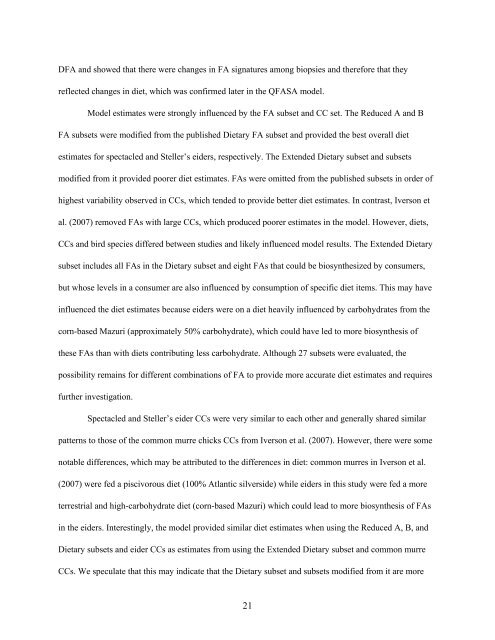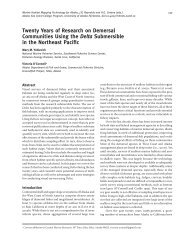724_Final Report.pdf - North Pacific Research Board
724_Final Report.pdf - North Pacific Research Board
724_Final Report.pdf - North Pacific Research Board
Create successful ePaper yourself
Turn your PDF publications into a flip-book with our unique Google optimized e-Paper software.
DFA and showed that there were changes in FA signatures among biopsies and therefore that they<br />
reflected changes in diet, which was confirmed later in the QFASA model.<br />
Model estimates were strongly influenced by the FA subset and CC set. The Reduced A and B<br />
FA subsets were modified from the published Dietary FA subset and provided the best overall diet<br />
estimates for spectacled and Steller’s eiders, respectively. The Extended Dietary subset and subsets<br />
modified from it provided poorer diet estimates. FAs were omitted from the published subsets in order of<br />
highest variability observed in CCs, which tended to provide better diet estimates. In contrast, Iverson et<br />
al. (2007) removed FAs with large CCs, which produced poorer estimates in the model. However, diets,<br />
CCs and bird species differed between studies and likely influenced model results. The Extended Dietary<br />
subset includes all FAs in the Dietary subset and eight FAs that could be biosynthesized by consumers,<br />
but whose levels in a consumer are also influenced by consumption of specific diet items. This may have<br />
influenced the diet estimates because eiders were on a diet heavily influenced by carbohydrates from the<br />
corn-based Mazuri (approximately 50% carbohydrate), which could have led to more biosynthesis of<br />
these FAs than with diets contributing less carbohydrate. Although 27 subsets were evaluated, the<br />
possibility remains for different combinations of FA to provide more accurate diet estimates and requires<br />
further investigation.<br />
Spectacled and Steller’s eider CCs were very similar to each other and generally shared similar<br />
patterns to those of the common murre chicks CCs from Iverson et al. (2007). However, there were some<br />
notable differences, which may be attributed to the differences in diet: common murres in Iverson et al.<br />
(2007) were fed a piscivorous diet (100% Atlantic silverside) while eiders in this study were fed a more<br />
terrestrial and high-carbohydrate diet (corn-based Mazuri) which could lead to more biosynthesis of FAs<br />
in the eiders. Interestingly, the model provided similar diet estimates when using the Reduced A, B, and<br />
Dietary subsets and eider CCs as estimates from using the Extended Dietary subset and common murre<br />
CCs. We speculate that this may indicate that the Dietary subset and subsets modified from it are more<br />
21



